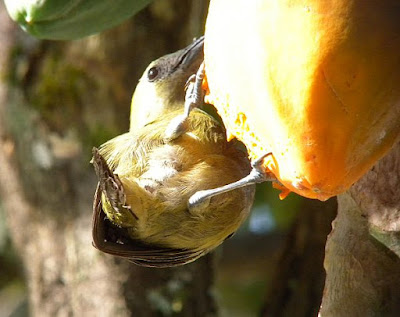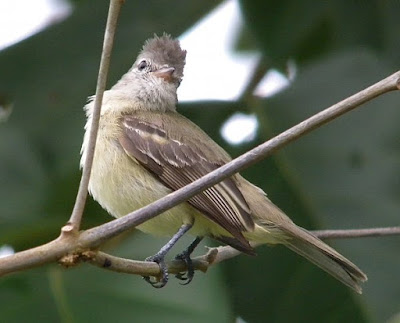Sunday 16 January 2011
After another early start, we drove along the same road as yesterday afternoon. From the vehicle we saw Red-throated and Black Caracaras, a pair of Crested Bobwhites, a pair of White-headed Marsh-tyrants, Red-breasted Blackbird, Ruddy Ground-dove and the rarer Plain-breasted Ground-dove. We never did see a Common Ground-dove. We turned off along a track that crossed an area of cleared forest. Clearance was obvious, a process that Cecilia calls “llanification” where forest becomes open damp grassland, the “llanos” of Venezuela. Given the riches that we were about to encounter in the true forest this process is a tragedy.
We were on our way to find a Harpy Eagle, the young bird that had featured in a BBC film and was still in the area although now 18 months old. We had with us Xavier, someone who knew this forest intimately and could almost be guaranteed to find Harpies. The bird was still based around the nest tree so we were fairly confident we would find the bird.
But first we had to get there. The track, rough but not too bad, suddenly entered a muddy patch and we were stuck. While we waited for Alberto and Xavier to extricate the vehicle we did some birding. Overhead were Greater Yellow-headed and King Vultures while below were Green Ibis, Black-collared Hawk, Long-tailed Tyrant, Red-and-green Macaw, Paradise Jacamar and three woodpeckers: Crimson-crested, Lineated and Yellow-tufted. Swallow-winged Puffbirds were a feature. They sat on the very tops of dead trees where they made sudden flycatching forays. Their plump silhouettes were distinctive.
Eventually we were on our way and when we arrived at a small clearing with a small building we parked. It was a fairly short walk to the nest tree. On the way we encountered a small group of White-faced Capuchin Monkeys. As they crashed off through the trees we managed a brief view of their follower, a Black-faced Hawk which eats lizards disturbed by the monkeys.
Our target bird wasn’t there. Xavier disappeared down various tracks but found nothing. Our target bird wasn’t there so concern immediately set in. What if we dipped on the main focus of the trip! Meanwhile some of us climbed the 10 metre tower the BBC had built for their camera and scoured the surrounding forest. Again there was nothing although a nearby White-chinned Hummingbird was new. Then Xavier walked round the far side of the tree and a Harpy Eagle suddenly appeared. It landed in the tree in full view. It was huge. The formidable bill and the enormous talons showed the power of the bird but the forward facing black eyes were surprising gentle. We spent a long time looking at and photographing this bird. After all, we probably would never see another one.
There were other birds too. The Ruddy Pigeons were fairly mundane but the male Rose-breasted Chat was colourful while the view of an Eastern Long-tailed Hermit was tantalisingly brief. A pair of Dusky Antbirds, like all birds whose names start with ant.. gave us the runaround until we eventually saw them.
We walked back to the vehicle and ate our lunch at the building. Entertainment was provided by a Black Nunbird that appeared on the far side of the clearing and a dog that seemed to like the smell of our food. Chocolate and coffee was produced here from the basic raw materials and we were provided with small mugs of very acceptable drinking chocolate.
On our return we got stuck again. More birding while the vehicle was extricated gave us a flock of Green Oropendolas and Purple and Violet Euphonias. But we had lost time and the sun was setting. We were now driving in the dark but this had the advantage of providing us with a few night birds: a Ferruginous Pygmy-owl on a gate and Spot-tailed Nightjar and Pauraque on the road.
Harpy Eagle - The largest Eagle in the world and the star bird of the trip. This individual featured in a BBC Natural World program in early 2010 as it was filmed hatching and up to a free flying state. Eighteen months after hatching the youngster, now approaching adulthood, still returns to the nest tree and calls for food. Even though it can hunt for itself the bird still relies on food from it's parents to some extent. Apparently they return to the nest about once a week.To view a video of the Harpy Eagle click here

Monday 17 January 2011
Another start before dawn prior to a day in the Imataca Forest, but before we got there we saw by the road a Rufescent Tiger-heron (the only one of the trip), a pair of Black-crowned Tityras and a Pearl Kite perched by its nest. We arrived at the bridge over the Rio Grande. On a wire over the river was a Ringed Kingfisher and later an Amazon Kingfisher followed by a Green Kingfisher. A walk alongside the river produced a McConnell’s Flycatcher and a White-necked Jacobin. Overhead flew a Short-tailed Hawk. We then continued along the track beyond the bridge. Jim almost immediately got onto a male White-crowned Manakin but nobody else saw it. Further on we came across a White-chested Emerald and a pair of Pied Puffbirds. The woodland here had a relatively open canopy and the upper level birds were comparatively easy to see. A pair of Paradise Jacamars sat on an exposed horizontal branch, a Black-necked Aracari sat high a tree, a Yellow-green Grosbeak was a little lower down while Violaceous and Purple-throated Euphonias, a Blue Dacnis, a Turquoise Tanager and Green and Purple Honeycreepers fed among a flowering tree. It was the lower level birds that gave us trouble. A Great Antshrike was fairly easy to see but a Slate-headed Tody-tyrant, responding to Cecilia’s recording, flew back and forth over the track but defied this observer’s eyes for some time. When we came to the closed canopy rainforest we heard, but did not see, White-tailed and Violaceous Trogons, Spotted and Thrush-like Antpittas. However we did see Wedge-billed and Buff-throated Woodcreepers.
In the afternoon we moved to a different area where we ventured into the rainforest along a narrow trail. It had clouded over and rain was imminent. There was a sudden rush of activity and we were in the middle of a feeding flock. Birds were above us, moving through the canopy at speed. We picked up the flock leader, Fulvous Shrike-tanager, Red-and-black Grosbeak and Yellow-olive Flatbill but it was very difficult trying to see the birds let alone identify them.
In the afternoon we moved to a different area where we ventured into the rainforest along a narrow trail. It had clouded over and rain was imminent. There was a sudden rush of activity and we were in the middle of a feeding flock. Birds were above us, moving through the canopy at speed. We picked up the flock leader, Fulvous Shrike-tanager, Red-and-black Grosbeak and Yellow-olive Flatbill but it was very difficult trying to see the birds let alone identify them.
We had a bit of luck further on. A Black Curassow walked across the track and a little later we saw another high in a tree. A strange long-tailed lizard immobile on a tree trunk by a small stream attracted our attention. It was a Common Basilisk that only moved when Cecilia touched it and made her leap backwards about 10 feet!
It now began to rain and soon we were sheltering under our umbrellas. This was a real downpour but it was over in an hour and we were on our way to try for a very elusive bird. When Cecilia played the call we got an immediate response from the top of the slope. It was a Rufous-winged Ground Cuckoo. The bird came closer and we heard the bill-clicking then Rob and Jim had brief views from 15 metres. To give an idea of the difficulty of seeing this species, Cecilia has never seen one.
It was dark as we returned to our hotel. Another Spot-tailed Nightjar flew up from the road.
Birds Seen on the road
| |
|
|
Southern Lapwing - At the same pool as the Sandpiper. Too close for a clear shot. Taken from the vehicle.
|
|
Burrowing Owl - A chance sighting as we were moving between bases. Initially seen on a building the bird moved to a lower post and posed for us.
| |
|
Solitary Sandpiper - Passing a small pool we stopped to view a pair of Southern Lapwing and also found this individual. | |


































No comments:
Post a Comment